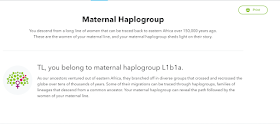Just when I was beginning to get thirsty for something, anything, new, upgraded and/or exciting in DTC DNA testing product features, I logged onto my 23andMe account this evening and spotted a "new report" for my Maternal Haplogroup. Did 23andMe finally update its antiquated genomic build for maternal haplogroup assignments?
I liked the old-version format of 23andMe for haplogroups — the haplogroup assignments for all shares were arranged on two separate pages (one for mtDNA and one for Y-DNA); we could conveniently see the haplogroup assignments of our DNA relatives next to their names, and we could easily find 23andMe online forum topics related to our haplogroups.
This "new" report is yet another 23andMe attempt to reorganize the way our information is displayed like its other recent offerings (see my "Explore Your DNA Family" blog here). It's much more visually stimulating than the last 23andMe haplogroup report but offers nothing substantive. Essentially a mirage. I'm still thirsty. But take a look anyways:
By clicking on the "L1" tab (left) shows another screen of my maternal haplogroup's probable migration route:
There is another section featuring a historic highlight about how my maternal haplogroup migrated along with the Bantu Expansion:
The last section shows an illustration explaining the genetics of Maternal Haplgroups (and course you can click on the "Scientific Details" tab at the top of the page to see more information):
By clicking on the tabs to the left reveals two more screenshots:
Of course I'd much rather 23andMe work on:
- updating its Ancestry Composition tool and Haplogroup predictions, including the outdated genomic build platforms (23andMe is on Build 7 while Build 17 was released February 2016), and really all DNA companies should be offering full mitochondrial sequence tests only;
- restoring our ability to see the Chromosome Paintings of people with whom we're sharing;
- implementing an in-house family tree utility;
- adding an "Ethnicity" segment element to the chromosome browser/mapper tool where customers can see displayed the location, size AND ethnicity(s) of shared DNA segments.
###END###









As usual, this was an excellent overview. Again, I'm so with you regarding your concluding bullets.
ReplyDeletenice post
ReplyDelete